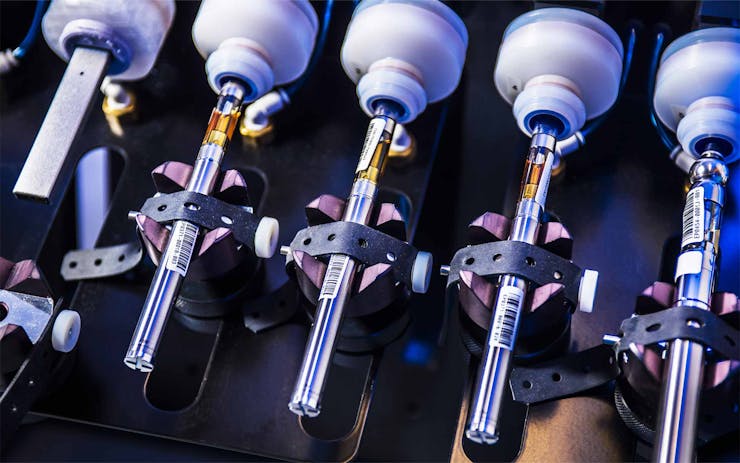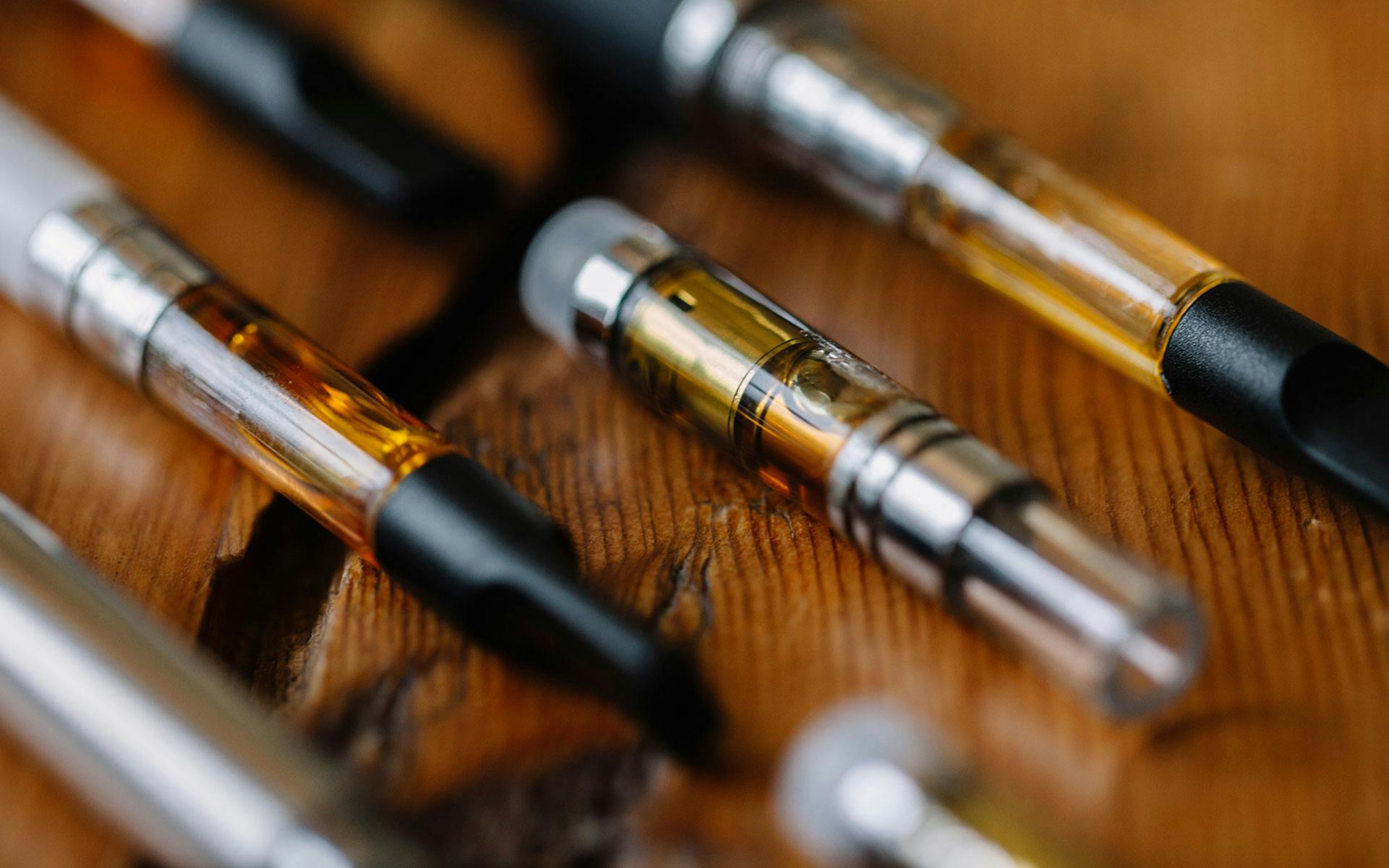On Jan. 12, the US Centers for Disease Control and Prevention (CDC) posted some good news about vaping-associated pulmonary injury (VAPI).
After 2,700 injured and 60 dead since August 2019, it appears the tainted THC vape cart nightmare of 2019 has concluded.
By mid-January, hospitals in the US reported zero new VAPI deaths in the prior seven days. New injuries were down to just four.
Leafly's research found a 12-year pattern of tainted or shoddy vape products harming consumers.
But going forward, weekly injury reports aren’t likely to drop to zero again.
That’s because VAPI-like injuries started before 2019, experts say. Vitamin E oil—the cause of nearly all VAPI injuries and deaths in 2019—hit the illicit market for THC vape cartridges in late 2018. But reports of defective batteries and tainted cartridges go back more than a decade.
A medical literature review by Leafly finds a 12 year-old pattern of tainted or shoddy vape products harming consumers long before the mass poisoning drew national attention to the issue in 2019.
Among the findings:
- Injuries from unregulated vapes—which are commonly called e-cigarettes, mods, JUUL-like pod systems, e-juice refill boxes, or cartridges—have been a simmering problem since their introduction to the US market in 2007.
- Contamination can exist beyond any single drug ingredient. In general, state-regulated THC cartridges are far cleaner than unregulated nicotine and CBD cartridges. That’s because federal rules on nicotine purity remain vague and unresolved. CBD? To be determined. By contrast, states like California heavily regulate THC and CBD vape purity. As a result, investigators report zero confirmed vaping injuries associated with the exclusive use of a licensed store product in California.
- Injuries come from more than just vitamin E acetate, the most notorious toxin of 2019. Rare nicotine overdoses—which can induce migraines, panic attacks, and heart attacks—exist in self-reports dating to 2009. Rare reports of lipoid pneumonia from dirty e-juice date to at least 2012. Since their introduction, some unregulated vapes have almost certainly contained toxic pesticides, metals, solvents, oils, and heated byproducts.
- Consumers must use common sense. Stay away from untested, unregulated electronic drug-delivery systems, especially if you’re a past smoker, asthmatic, senior citizen, juvenile, chronic user, and/or poly-drug user. Use low temperatures and practice moderate use.
- National regulations are long overdue. Researchers have called for pure, tested vape ingredients since at least 2011. As long as Americans inhale low-quality, impure drug aerosols, a certain percentage of them will suffer inhalation injuries.
- After last year’s vitamin E-related VAPI outbreak, the CDC has said the number one proactive thing regulators can do is “ensure chemicals of concern are not introduced into the vaping supply.”
Only state-licensed cannabis vapes are regulated
Consumers buying JUUL-style pods at a gas station or vape shop often assume the FDA has regulated those products for purity. Not so. To this day, the FDA has done nothing to ensure product purity in US vaping products, or what the agency calls electronic nicotine-delivery systems. Only licensed cannabis products in legal states are regulated.
Shop highly rated dispensaries near you
Showing you dispensaries near“States around the country have been effectively regulating cannabis and establishing safeguards to prevent potentially dangerous products from reaching consumers for years,” said Morgan Fox, for the National Cannabis Industry Association, which just released a white paper, ‘’The Key to Consumer Safety: Displacing the Illicit Cannabis Market – Recommendations for Safe Vaping.’ “Meanwhile the FDA has been unable to pursue similar efforts or provide uniform guidance thanks to federal prohibition.”
In its latest Jan. 2020 guidance documents, the FDA seems focused on regulating nicotine flavorings, and less so on nicotine purity or device emissions.
Most importantly, little quality-control exists irrespective of the active drug ingredient in a vape. The FDA likes to talk about electronic nicotine-delivery systems (ENDS), but in the abstract, these are all “electronic drug-delivery systems” (EDDS).
Any type of EDDS can injure through low quality-control—whether the vape contains nicotine, THC, CBD, or other drugs. In 2013, researchers found a variety of non-nicotine chemicals in vapes, including diet drugs and erection drugs. Nowadays, some unregulated manufacturers are sticking substances like vitamin B12 or melatonin in vapes and selling them on Amazon. Amazon is a globally trusted brand, but the company enforces no quality control gate for vaping products. The New York Times recently highlighted a wave of anonymous China-based companies moving cheap products under “brand names” like ZGGCD and VBIGER.
Where it started: Nicotine vape injuries
Smoking a regular tobacco cigarette can cause long-term health issues like emphysema, cancer, and death. That’s why Chinese inventor Hon Lik says he came up with the first e-cigarette in 2003.
As the popularity of the new devices spread, regulators gave e-cigarettes a pass. The first devices were introduced in Europe in 2006. They arrived in the US the following year with the appearance of a product called NJOY. Government officials figured smoked tobacco’s sky-high risk profile dwarfed that of a novel, low-temperature drug aerosol.
They were correct—so far—about that. Millions of adult cigarette smokers switched to nicotine vaping. Health officials in the UK have heralded that as a major positive advancement in public health, saving countless smokers an agonizing early death.
But if vaporizers reduced a user’s long-term harm, they came with new short-term risks. In rare instances, shoddy e-cigs or vaping devices caused acute injuries from exploding devices, or pneumonias from inhaled oil, early case reports show.

A test tube rack stocked with examples of vaping devices, obtained for testing purposes by the Centers for Disease Control and Prevention (CDC). (Courtesy of Lauren Bishop/CDC)
Vapes rapidly evolved past the early disposable, fully-enclosed, cigarette-looking products like NJOY and blu.
Customers bought bigger batteries, ran them at higher voltages, and attached them to bigger liquid reservoirs that they refilled with their own mixes of liquid bought online.
Entrepreneurs worldwide appropriated safe dietary ingredients like cinnamon and fruit flavorings, and turned them into novel, untested, problematic inhalants. The ‘e-juice box’ became popular by 2012.
Disposable cartridge systems came onto the US market around 2012, first with the so-called ‘510’ thread cart. Modern-era ‘pod’ systems blew up when JUUL arrived in 2015. Hundreds of brands and counterfeits proliferated. Today, millions of consumers vape. It’s a multi-billion dollar industry.
Limited reporting then, ‘syndromic surveillance’ now
Up until 2019, the US market for EDDS combined no regulatory quality control with little systematic medical reporting of adverse events. Americans engaged in a massive, uncontrolled 13-year field trial of EDDS until the VAPI outbreak triggered what the CDC calls “syndromic surveillance.”
As VAPI cases proliferated in 2019, the CDC and national media spurred hospital officials across America to look for vape lung injuries. Newer, more specific hospital record codes for the condition are scheduled to debut in April 2020. Thanks to the new awareness created by VAPI, we’re now catching and recording far more adverse EDDS events. The lights are on. The mass experiment with vaping now includes reporting.
Looking beyond vitamin E oil
According to the CDC, most 2019 injuries came from vitamin E acetate in street-market THC vapes. But a persistent few are reportedly associated with vaped nicotine, CBD, or other active drug ingredients. What’s going on?
As a fuller picture comes into view, we can infer that past vape-induced lung injuries occurred as well, regardless of active drug ingredient. If that’s the case, evidence of them should exist. And indeed it does.
Two dozen severe VAPI cases in last eight years
As VAPI cases surged last fall, the Internet Book of Critical Care—a clinician’s online resource—posted information on “about two dozen” VAPI case reports going back as far as 2012.
But “the actual number of cases is probably considerably larger,” Dr. Josh Farkas wrote in a blog post on how to identify and treat VAPI. Farkas is an expert-trained ‘rescusitationist,’ and assistant professor of Pulmonary and Critical Care Medicine at the University of Vermont. When you stop breathing, doctors and medical technicians like Farkas are the people who get you breathing again. “I’ve seen one patient with probable VAPI,” he wrote, “but didn’t submit it for publication (once several cases have been published, there’s little impetus to publish additional case reports).”
“With an increasing recognition of this phenomenon and a rising popularity of vaping, the number of diagnosed cases will increase,” Farkas wrote.
The CDC initially focused on dramatic cases of minors suffocating in their own lungs. But “over time, milder cases will likely be appreciated as well,” he added.
Injuries and adverse self-reports start with NJOY in 2009
For those milder cases, Leafly looked into the FDA’s “tobacco product problem reports” dating back to 2009, just two years after the NJOY e-cigarette hit the US market.
Commonly reported adverse events included nicotine poisonings, which can cause migraine and heart attack; burns from e-cigarette devices exploding; and cases of acute respiratory distress that resulted in hospitalization or death. Consumers reported vaping weirdly named e-juices and suffering from what sounds like lung injury—symptoms of hypoxia, shortness of breath, and malaise. Sometimes they reported use of flavors found to produce diacetyl, a toxin which causes so-called popcorn lung.
E-commerce has democratized the production of a medical device. Can you imagine if people made cardiac stents and catheters in their condos? With stuff they bought off the internet?
Again, the FDA has never regulated EDDS for purity or quality. The FDA relied on nicotine vape makers to self-report their product ingredients. Some did, many didn’t. A vast spectrum of nicotine vape quality exists. Vast swaths of vape makers who do not self-report ingredients operate with impunity. Literally anyone with a credit card could—and still can—start manufacturing EDDS devices in their garage by purchasing everything they need online.
E-commerce has democratized the production of a medical device. Can you imagine if people made cardiac stents and catheters in their condos? With stuff they bought off the internet? Of course, there’d be thousands injured and dozens dead.

Examples of counterfeit THC vape and JUUL pods for sale in downtown LA’s wholesale district. (David Downs/Leafly)
Thousands of adverse events since 2008
For milder, non-published cases of vape-induced lung injury, you must go beyond the medical literature and FDA adverse events, and into the murkier world of self-reports.
On Jan. 6, a University of California Riverside research team announced they had used search functions to read 1.45 million posts in an online e-cigarette forum, and find reports of vape-related lung injuries. Researchers zeroed in on seven health sub-forums, comprising more than 40,000 entries from 2008 to 2015.
There they found far more adverse events than the FDA has collected. The five top symptoms the UC Riverside team found were headache, coughing, pain in the throat, itching, and malaise.
More seriously, vapers self-reported VAPI-like symptoms to online forums for at least seven years, “suggesting that cases similar to those in the current epidemic have existed previously and been unreported or not linked to vaping,” the researchers wrote.
Self-reports of severe lung damage like bronchiolitis obliterans, or pulmonary edema, numbered under ten each. But more common minor VAPI-like symptoms showed up regularly: chest pain; shortness of breath; cough; nausea; vomiting; diarrhea; fever; chills; fatigue/malaise; and headache. Also, neurological and gastrointestinal VAPI symptoms “overlap those found in our study,” the researchers wrote.

A Centers for Disease Control and Prevention (CDC) lab technician pipettes a sample of vitamin E acetate found in THC vape carts on the street. Burning vitamin E acetate may produce ketene, a potent lung poison, Irish researchers concluded in 2020. (Courtesy of Lauren Bishop/CDC)
The UC Riverside study had a big limitation: The researchers could not separate an authentic JUUL user from a fake JUUL user, or a street-market THC cart consumer from a THC vaper who purchased at a state-licensed cannabis store. It’s also not clear which e-cigarette forums the researchers crawled—they did not respond to repeat Leafly’s emailed questions. The forums likely contained a cross-section of users of e-cigarettes, pods, boxes, and untested THC carts.
Literature matches labs’ experience
The idea that vape-induced lung injuries are not new, nor limited to vitamin E acetate, doesn’t surprise longtime cannabis lab operators in California.
‘Lower-grade, more chronic injuries from these contaminants are tougher to identify than acute injuries, and I think that’s a big problem,’
Josh Wurzer, founder of state-licensed SC Labs, told Leafly: “Obviously people have been getting sick before 2019.”
In 2019, Wurzer began testing a variety of nicotine pods out of sheer curiosity. California enacted world-leading cannabis vape purity standards in mid-2018, and he wanted to know if nicotine vape cartridges met the same purity standards. Wurzer said he found that many off-the-shelf nicotine pods would not pass California’s legal cannabis standards. In fact, many would fail by a lot.
SC Labs found some nicotine products would have failed for the presence of plant growth regulator, pesticides, or heavy metals.
One nicotine pod had 12 times California’s allowable level of lead for a legal cannabis product. Lead kills brain cells, and the EPA states no amount of it counts as safe.

Makers of illicit-market marijuana oil can concentrate crop pesticides by a factor of 10 or 20. Contaminated oil gets diluted with one chemical, re-thickened with another, and injected into a cheap cartridge that can leach metals and plastics into the oil. Faulty or cheap electronics can then burn the mix. Above, a Centers for Disease Control and Prevention (CDC) laboratory technician works with a vape. (Courtesy of Lauren Bishop/CDC)
Multiple brands, Wurzer said, would have failed for the plant growth regulator Daminozide. There’s little inhalation data on the chemical, but five grams of Daminozide can kill a one-kilo rabbit, via the skin. California cannabis rules ban any detectable levels of it in a vape.
The damage depends on the dose. Wurzer says he believes doctors are likely missing cases of milder poisoning. “Lower-grade, more chronic injuries from these contaminants are tougher to identify than acute injuries, and I think that’s a big problem,” he told Leafly.
Josh Swider runs the licensed licensed pot lab InfiniteCal. He’s been testing street-market THC cartridges for several years. InfiniteCal has consistently found high levels of metals and pesticides in them.
Last autumn, InfiniteCal tested 30 THC carts obtained from the illicit street market in a buyback program ran by Mankind dispensary in San Diego. The results: 79% of the carts failed California testing standards. Every street cart contained vitamin E acetate—from trace amounts up to 20%. More than 60% of street carts failed for pesticides. One cart had 87 times the allowable limit for lead.
In a random sampling of the cannabis products seized from unlicensed retailers during a major enforcement operation in LA, 75% were found to contain undisclosed cutting agents such as Vitamin E Acetate, Polyethylene Glycol, and Medium Chain Triglycerides.https://t.co/YYgw9gbmWJpic.twitter.com/YkPQr9bXbc
— BCC Info (@BCCinfo_dca) January 27, 2020
“I think VAPI has been around for a while,” Swider said. “We saw vitamin E acetate in the street supply as early as 2018.”
Makers of illicit-market weed oil can concentrate crop pesticides by a factor of 10 or 20, Swider said. The contaminated oil gets diluted with one chemical, re-thickened with another, and injected into a cheap cartridge that can leach metals and plastics into the oil. Faulty or cheap electronics can then burn the mix at several hundred degrees.
“They take a bad problem—contaminated oil—and make it worse,” he said.
The most common adverse self-report in the UC Riverside study—headache—can come from an over-concentration of nicotine. But Swider has also seen patients with headaches associated with pesticides in a vape.
‘These unregulated products will continue to be available and profitable until states and the federal government start treating cannabis more sensibly.’
“We see people bring in vapes that are giving them a headache and we test it and it’s 20 parts per million myclobutanil.” Myclobutanil kills fungus on wine grapes and shows up in wine. Manufacturers don’t know myclo’s inhalation toxicity, but they advise against it.
Going forward, Swider wants closer attention paid to heavy metals in vape cartridges, as well as more research and regulation of the byproducts from burning additives. For example, there’s at least one confirmed report of “cobalt lung” from a cheap heating coil in a refillable wax pen. Researchers found cobalt in a woman’s zen pen, and in her lungs.
As for additives—earlier this year, Irish researchers found that heating vitamin E acetate creates the powerful lung toxin ketene, which can blister the lungs. Oregon researcher Robert Strongin suspects toxic pine resin fits the profile of a THC oil cutting agent—the gold, thick, piney toxin mimics THC oil. SC Labs’ Wurzer has heard early reports of vitamin D oil as a novel cutting agent in 2020.
“I still vape carts that I buy in a regular [state-licensed] shop,” said Wurzer. “But you can’t pay me enough to touch something that someone brings in off the street.”
“Unfortunately, these unregulated products will continue to be available and profitable until states and the federal government start treating cannabis more sensibly,” said Morgan Fox at the NCIA. “We’re working with Congress to establish a federal regulatory structure for cannabis products when it is finally de-scheduled.”
Vape licensed, vape safe
Years of peer-reviewed research, industry experience and online self-reports indicate that EDDS must be high-quality, with pure ingredients, and used as directed—or vapes can end up being more harmful than smoking plain old tobacco.
“I still believe in vaping,” said Wurzer. “I think vaping can be safer than smoking, both for cannabis and for tobacco. Is it ever going to be zero risk? Nothing is. But it can be much safer. You need proper regulations and oversight, and that’s become obvious now.”







